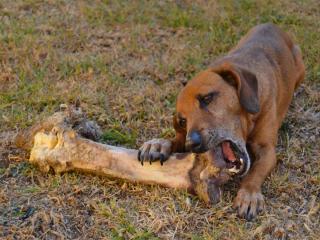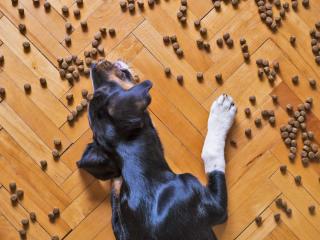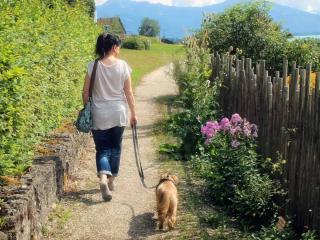Your dog steals food, endlessly licks its bowl, and sniffs around all day looking for a snack? So why do dogs always feel hungry? Let’s delve into this topic and offer some handy tips to help.
Initial theories on dog hunger
 We domesticated dogs. Yet, they were originally carnivorous predators that hunted non-stop. Quick consumption of prey was crucial: not just to avoid theft, but because they didn’t know when their next meal would come. Constant hunger fueled their hunting instinct.
We domesticated dogs. Yet, they were originally carnivorous predators that hunted non-stop. Quick consumption of prey was crucial: not just to avoid theft, but because they didn’t know when their next meal would come. Constant hunger fueled their hunting instinct.- In dog hierarchy, the alpha male brings back food and enjoys prime cuts. Subordinates get leftovers. They need to eat fast to get a greater share.
- In a litter, there might be too many puppies. At birth, they jostle for access to mother’s milk. This fear of food shortage continues throughout a dog’s life.
Did you know? A dog’s taste palette is simpler than ours. They only discern salty, sweet, bitter, and sour.
Diseases related to food
- A dog that constantly eats might just be bored or lack activity. Searching for food becomes a fun pastime.
 If your dog suddenly feels hungrier, it might suffer from polyphagia. This condition triggers excessive hunger without feeling full, causing a major appetite boost. Consult a vet to check for diabetes, brain tumors, or acute gastritis in your dog.
If your dog suddenly feels hungrier, it might suffer from polyphagia. This condition triggers excessive hunger without feeling full, causing a major appetite boost. Consult a vet to check for diabetes, brain tumors, or acute gastritis in your dog.- Potential issues include hyperthyroidism, intestinal cancer, and digestive problems.
- Perhaps your dog has intestinal worms. Consider deworming every month up to 6 months of age, and then twice a year.
- Neutered or spayed dogs tend to gain weight; missing sex hormones increase appetite.
Dog satiety
- The hypothalamus is the part of the brain that controls satiety.
- After evaluating food quality, quantity, energy input, and blood sugar level, the hypothalamus springs into action. Sensory triggers like stress and boredom, or hormonal triggers like ghrelin (induces hunger) and leptin (brings about satiety) also play a role.
Helping your dog feel full
 Offer premium quality food so your dog gets proper nutrition. Aim for lean protein (at least 30%), fiber, oil, and minimal grains.
Offer premium quality food so your dog gets proper nutrition. Aim for lean protein (at least 30%), fiber, oil, and minimal grains.- Feed at regular times. If food dominates your dog’s thoughts, split its portion into three meals: morning, noon, and evening. Eating on a schedule helps dogs know when to expect food and avoids conversion into fatty tissue.
- Use a slow-feeder bowl or kibble dispenser. Dogs should eat slowly and chew well to recognize fullness.
- Some soak their dog’s food to take up more stomach space, or extend it by adding green beans and zucchini.
- A peaceful, stress-free meal is crucial. A stressed dog produces cortisol, a hormone with the side-effect of boosting appetite.
- Size your kibble portions based on breed, age, activity, and individual circumstances. Your vet can provide guidance.
- Never feed your dog scraps from the table during meals. Don’t give in if it begs outside of set times. Treats? Only once in a while. Such bad habits disrupt satiety control.
- Take long walks with your dog. When relaxed, it releases endorphins, soothing hormones that counter anxiety and cut back cortisol production.
Did you know?
Because of a missing DNA sequence in the POMC gene, Labradors and Golden Retrievers always feel hungry. They can’t sense fullness, according to a study by geneticist and vet Eleanor Raffin from the University of Cambridge (published in Cell Metabolism). Easily trainable with food, they excel as service dogs for people with disabilities.
Risks of overfeeding
Obesity is a clear threat:
- It reduces your dog’s lifespan.
- Leads to strokes and respiratory issues.
- Invites arthritis.
- The heavier a dog, the less it feels full. Fat resists leptin, so the brain gets confused. Weight normalization helps.
- Big breeds risk stomach torsion. Putting feed bowls higher up, like atop a stool or small ledge, will promote better digestion for them.
Smart tips
- If your dog is healthy and has an insatiable appetite, give it a carrot. Good for tartar since dogs have to chew.
- It’ll keep them engaged.
- Treats? Won’t ruin your dog’s figure, so they’re ok on a training basis or to set a simple routine.
- Assessing your dog’s weight is easy: run your hands along its sides. If you feel the ribs faintly through the skin and fat, no weight issues there!
- For reasonably-sized dogs, weigh yourself alone and jot it down. Next, weigh yourself holding up your dog. Subtract the two numbers to compute its weight.
Ponder this: “Learning from mistakes is giant leap forward” – Sharins
Images: 123RF: Aleksandr Finch; Pixabay: Manfred Antranias Zimmer, Matuka Coulton, Michelle
Written by Lydie Dronet | With over 20 years in the field of animal care, Lydie shares her paws-on expertise and experience. Other topics she loves delving into are nutrition and the medicinal uses of plants.


 We domesticated dogs. Yet, they were originally carnivorous predators that hunted non-stop. Quick consumption of prey was crucial: not just to avoid theft, but because they didn’t know when their next meal would come. Constant hunger fueled their hunting instinct.
We domesticated dogs. Yet, they were originally carnivorous predators that hunted non-stop. Quick consumption of prey was crucial: not just to avoid theft, but because they didn’t know when their next meal would come. Constant hunger fueled their hunting instinct. If your dog suddenly feels hungrier, it might suffer from polyphagia. This condition triggers excessive hunger without feeling full, causing a major appetite boost. Consult a vet to check for diabetes, brain tumors, or acute gastritis in your dog.
If your dog suddenly feels hungrier, it might suffer from polyphagia. This condition triggers excessive hunger without feeling full, causing a major appetite boost. Consult a vet to check for diabetes, brain tumors, or acute gastritis in your dog. Offer premium quality food so your dog gets proper nutrition. Aim for lean protein (at least 30%), fiber, oil, and minimal grains.
Offer premium quality food so your dog gets proper nutrition. Aim for lean protein (at least 30%), fiber, oil, and minimal grains.